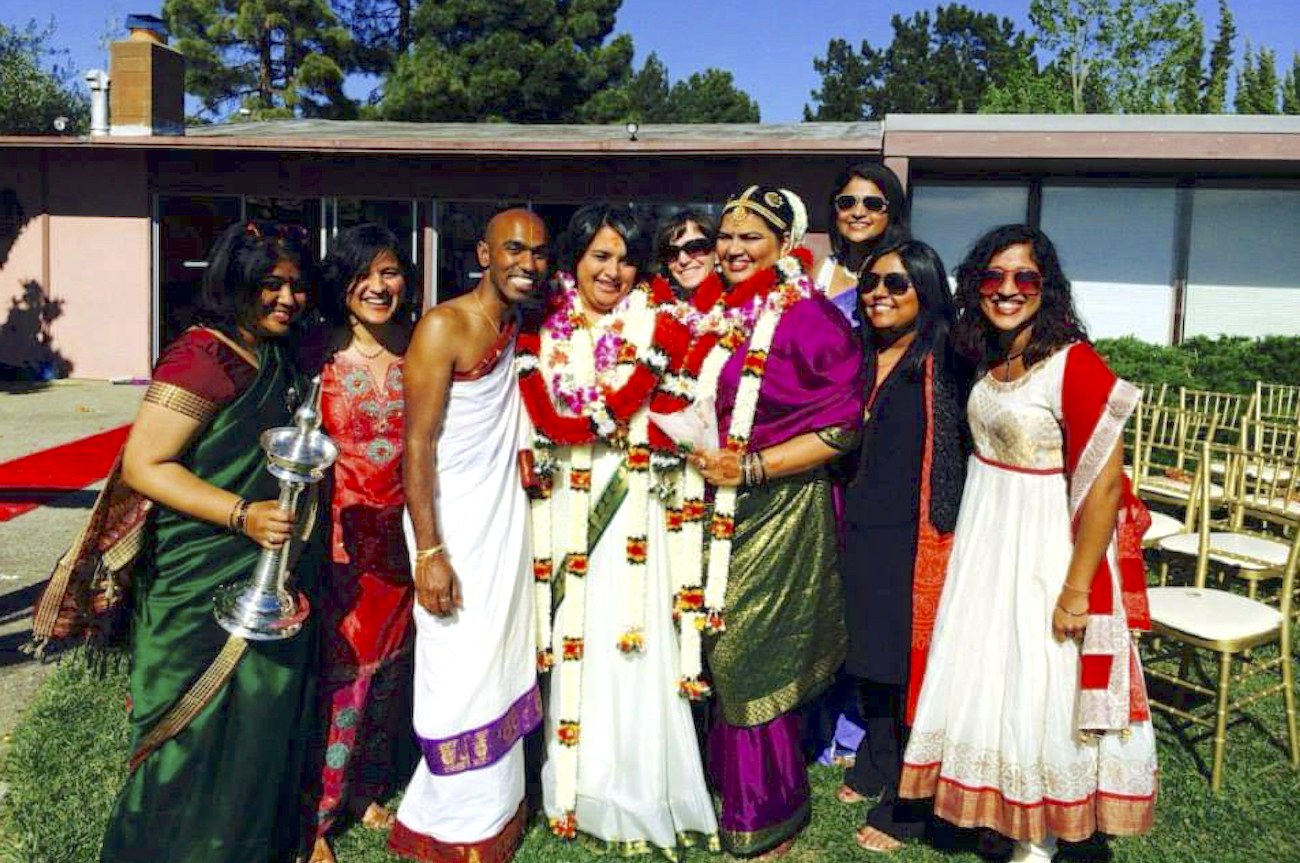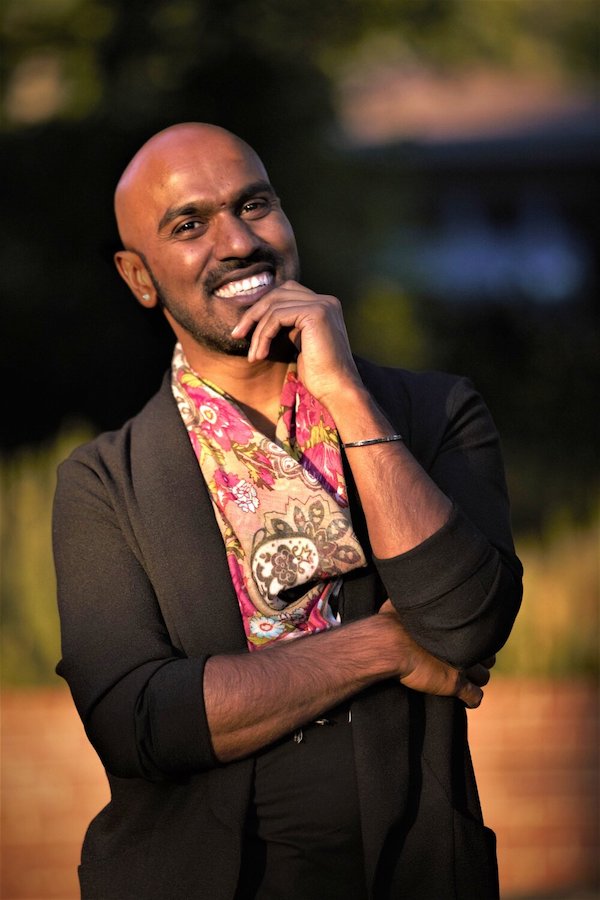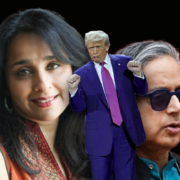Prem Pujari: A Conversation With Hindu Priest Officiating Same-Sex Weddings in the Indian American Community
- Raja Gopal Bhattar, who identifies as genderqueer, takes great pride in solemnizing LGBTQ, interfaith, inter-ethnic, and nondenominational weddings.

Raja Gopal Bhattar, (they/them/theirs), Ph.D. uses gender-inclusive pronouns and identifies as genderqueer. They hail from a long lineage of over 20 generations of Hindu scholars and pundits from the Sri Vaishnava tradition across southern India and the United States. Bhattar’s family is originally from Srirangam, Tamil Nadu.
Bhattar’s grandfather was a Sanskrit scholar who was one of the chief pujaris at the Alamelumanga (Lakshmi) temple in Tirupati for many years. Their great uncle, Sri Sampat Kumar Bhattar, moved to the U.S. in the early 1970s to consecrate Sri Venkateswara Temple, Pittsburgh, in post-1965 America. In the mid-1980s, Bhattar’s father came as a priest at the Rama temple in Lemont, Illinois, and Bhattar joined him in 1990 at the age of seven.
Bhattar grew up in temples their father was serving across the country. After a year in Illinois, they moved to the Sri Venkateswara temple in Malibu, California, for a couple of years. Then they moved to the Sri Satyanarayana Temple in Middletown, Connecticut. Bhattar learned the intricate Sanskrit hymns, decorated the murtis (idols), and mastered the religious rituals while helping their father with the poojas.
While becoming aware of their gender identity and exploring sexual orientation, Bhattar realized that Hindu heteronormative practice did not fit with many different stories of gender diversity, same-sex union, the celebration of sexuality within the Hindu tradition. And yet, they felt that the Hindu practice, customs, and rituals in the Indian community were very heteronormative and didn’t leave any space to talk about sex, sexuality, or gender identity.
During undergraduate school at Boston University, Bhattar took courses on Hinduism and realized that there is no one framework to understand the religion. The multivocality, plurality, and diversity of Hindu belief systems create space for different interpretations of texts and practices. Bhattar says they understood “the ability to hold and celebrate complexity and contradiction as part of the Hindu tradition.” After doing a Master’s and Ph.D. at UCLA in student affairs and organizational change, Bhattar has served as an administrator in student affairs for a couple of decades. Presently, he serves as a diversity and equity-based consultant, organizational development facilitator, and transformative leadership adviser.

Bhattar has been conducting Hindu weddings since 2010 and takes great pride in officiating LGBTQ, interfaith, inter-ethnic, and nondenominational weddings. His website highlights testimonials from various couples from many different orientations, ethnicities, and races. They are full of praise for Bhattar’s sensitivity and empathy in conducting these rituals. So far, Bhattar has performed 24 weddings, most of which have been for same-sex couples. They officiate two to three weddings a year but due to Covid, five weddings by the end of Dec 2021.
Excerpts from an interview with Raja Gopal Bhattar:
What prompted you to become a Hindu priest?
I conducted the first wedding ceremony in 2010 of a college friend and her husband. She is white, and her partner is Indian. The meaning behind the ritual was important to the couple and their families, and they wanted a ceremony that honored both of their traditions.
When I was at UCLA, a lesbian couple — Hindu and Buddhist — had difficulty finding a priest to honor what it means to be a lesbian couple and create a ceremony that affirms their journey. They had deep spiritual roots. When they approached me, I infused Hindu and Buddhist elements as the foundation of the marriage ceremony.
I realized that having the knowledge of growing up deeply embedded in the Hindu tradition allowed me a unique way to offer good into the world. It has been part of reclaiming my identity and community in the process. I learned that I know traditions and critical consciousness to understand and explain the significance of the Hindu rituals, which makes the ceremony more meaningful and intentional.
When I talk to a couple, especially queer, I say that in the Hindu tradition, we value the soul and connections beyond our bodies which is affirmative of same-sex and diverse relationships.
What is your basic principle in conducting a wedding?
The Hindu wedding ceremony is not just a ritual but a code of conduct. It is to help the couple understand the commitment that they’re making to each other, not just in one life but seven lifetimes. So when I talk to a couple, especially queer, I say that in the Hindu tradition, we value the soul and connections beyond our bodies which is affirmative of same-sex and diverse relationships.
How is your Hindu service different from a traditional Hindu ritual?
What it means to be a Hindu is how we live. As a Vaishnavaite, I grew up in the tradition of Sri Ramanuja, who represents the Vishishtadvaita tradition where we believe that Atman (soul) and Brahman (source of all creation) are connected yet separate or contextualized dualism. Everything is complex, and everything is possible. There are spaces for both ends. For example, the first word in Rig Veda is Agni, also referred to as Dwimatre — of two mothers. A child of two women, which today we may call a same-sex lesbian couple. It does not fit into the heteronormative norm that is often espoused in our communities. But interpretation is a vital part of Hindu tradition.Ekam Sat Vipraha Bahuda Vadanti (There is one truth but the wise speak in many tongues).

In crafting a ceremony, I address aspects of ceremonies that don’t fit critical feminist and anti-caste worldviews and need to be reclaimed and recreated for today’s society. In the Hindu ritual, I try to transcend the heteronormative interpretation of the tradition and provide more inclusive perspectives.
For example, Kanyaddan (giving away the bride) may not always be relevant. In a queer and feminist context, Kanyaddan treats women as property which feels antiquated and not in line with our values and the world today. So I interpret it as Kutumba Angikaranam (family welcoming). It is welcoming a new person into our family. And I have both sides of the family receive a new child into the family rather than giving a child away.
In the South Indian tradition, the bride sits down on her father’s lap, and the groom puts an oxbow on her head, symbolic of the farmer and the cow. “May you be the cow and me the farmer.” While I appreciate the symbolism of the couple working together in cultivating the land and family, It is dehumanizing to tell the bride you are like a cow. I don’t do that because I don’t believe that it is essential. There are other ways that our wedding ceremonies represent equitable relationships and values without dehumanizing either person in the relationship.
Another ritual of the Mangal Sutra ceremony is during the Laja Homam(sacred fire). Typically the bride’s brother or sister helps out. Some queer couples say, “my blood families are not even here because they’re not supportive.” For me, in the Hindu tradition, the relationship has nothing to do with blood; it is about community and communal existence. So the role of the siblings holding a sense of responsibility and care so I ask them to identify a close friend who is like family to fill that role
In the heteronormative ceremony, the ritual Kashi Yatra is when the groom leaves the wedding to be a scholar, and the bride’s family has to beg the groom to stay and marry. It is to make the daughter feel that she is lucky to marry him. Instead, it should be he who is fortunate to marry her.
The ritual of Pravaram, where we name the family lineage, is always recited on the father’s side. For me, without the mother or grandmother and great grandmother, the couple wouldn’t be here, so why are we not naming them? So I start with the women first, the mother, the grandmother, the great grandmother, and parents. It is the female that allows the relationships to take forward. In a queer and feminist context, I honor the complexity of family. And then, I also name the father, the grandfather, and great-grandfather.
The mothers’ lineage or matrilineage is a new thing I add for both queer and inter-faith (Jewish- Hindu, Buddhist-Hindu, Christian–Hindu) or ecumenical weddings.

The ritual Saptapadi is not about who goes on the right or left but walking together. Seven steps are conventionally about living together and produce children for the continuation of family lineage. Some queer or heterosexual couples say we do not want children. I interpret it as the couple committing to supporting each other and building a stronger community. The intention is still there, and yet the interpretation is different. For me, that’s the difference.
How long is the wedding ritual you perform?
Typically 45 minutes to 2 hours depending on the elements incorporated and the couple’s various cultural and spiritual traditions.
What have you learned from performing this ritual?
Being genderqueer, I spent so much of my young adulthood running away from religion. Growing up in an orthodox temple community, I never felt I could be a good Hindu and honor my gender and sexual identities. Then I realized that faith has always guided me in my journey. I tell people that I don’t think I would have had the strength to understand and accept who I am as a genderqueer person if not for my spiritual foundation and religious tradition. And I wouldn’t know the importance of my spiritual roots had it not been to navigate a homophobic and transphobic world. Within a Hindu context, there are spaces for LGBTQ identity in our mythologies and scriptures. There are so many different opportunities for us to think about LGBTQ identity within our tradition that often gets overlooked or intentionally whitewashed.
In the last two years, there has been a shift from just same-sex couples wanting ceremonies to more and more heterosexual couples who emphasize a progressive approach and a feminist perspective to a wedding. “They see their relationship with each other as equals, and they want someone who can explain the meaning behind these different rituals. Especially when the service is happening with a mixed religious crowd, they don’t want people to sit there for an hour without knowing what has happened. They want people to be engaged. And so, having grown up in the U.S., I have the language ability to translate rituals in a way that makes the experience more inclusive and meaningful.
Have you faced any backlash for doing the queer weddings?
I’ve had some family members challenge me on my interpretations of the scriptures and some families of couples who have questions about “Are you sure this is ok in our religion?” but usually, they can understand my view and approach. As an educator, I take all feedback and resistance as opportunities to engage in dialogue and be clear in my values and practices.
Recently, Sri Ranganathan Kurrukal, a priest from the Canada Kanthaswamy Temple based in Toronto, received multiple death threats by text, phone, and social media. He has been accused of committing a crime for officiating a traditional Hindu wedding between two women.
What gives you the most satisfaction in performing the wedding?
I believe I am living out my true purpose of helping people reclaim our spiritual tradition and the inherent values of inclusion and equity within our culture. I also enjoy getting to meet couples and families around the country and helping to make this wedding journey accessible and intentional.
Annapurna Devi Pandey teaches Cultural Anthropology at the University of California, Santa Cruz. She holds a Ph.D. in sociology from Jawaharlal Nehru University, New Delhi, and was a postdoctoral fellow in social anthropology at Cambridge University, the U.K. Her current research interests include diaspora studies, South Asian religions, and immigrant women’s identity making in the diaspora in California. In 2017-18 she received a Fulbright scholarship for fieldwork in India. Dr. Pandey is also an accomplished documentary filmmaker. Her 2018 award-winning documentary “Road to Zuni,” dealt with the importance of oral traditions among Native Americans.


